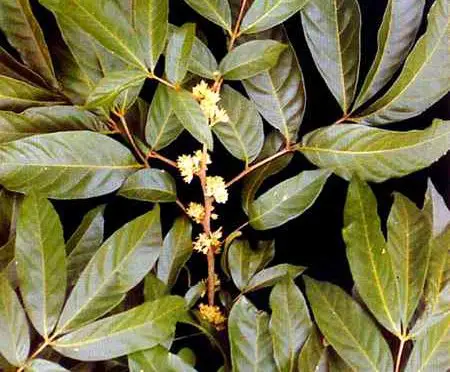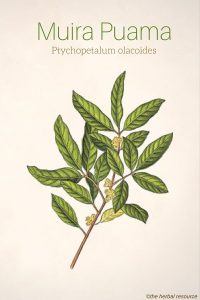Botanical Name: Ptychopetalum olacoides.
Other Common Names: Potency wood, mara puama, marapuama, marapama raiz del macho, and potenzholz.
Habitat: Muira puama, or potency wood, is native to the Brazilian Amazon.
It requires a tropical climate and plentiful moisture to thrive.
Plant Description: Muira puama is a small bush/tree that grows to a height of 5 meters and produces small, white, jasmine-scented flowers.
Plant Parts Used: The bark and root of this tree are used for medical purposes.

Therapeutic Uses, Benefits and Claims of Muira Puama
Muira puama has been used traditionally by tribes in Brazil and the surrounding South American countries. It is a popular, though not well researched, herbal supplement in Europe and North and South Americas.
Traditionally this herb was used by indigenous tribes as an aphrodisiac and to treat impotence. Chewing the barks, stems or root was the most popular method of administration.
Muira puama has also been used as a tonic for nervous conditions and depressions. It has been used to promote overall nerve function and to relieve nerve pain.
Some Amazonian tribes have used this medicinal herb to treat dysentery and rheumatism. A paste of the bark and/or root oils has also been applied topically to treat beriberi and paralysis.
In Europe, around 1930, it became a popular supplement for treating erectile dysfunction. It has been shown to be as effective as yohimbine in some cases, without the adverse side effects.
Although clinical studies and research are sparse, muira puama is still promoted today as a treatment for erectile dysfunction and as a male aphrodisiac.
It has also been used for gastrointestinal disorders and as a treatment for indigestion.
Muira puama does have a stimulant effect that leaves the user with a general feeling of well-being when taken in proper doses. Large doses may cause an overstimulation leaving the user feeling restless and affecting sleep.
This herbal supplement has also been shown, in animal studies, to improve mental focus and clarity. It may also help improve concentration and short-term memory.
It is also used to naturally treat hair loss.
Its stimulant effect also makes it useful as an herb for depression.
Women have used muira puama to treat the discomforts of menopause, as well as cramping associated with menstruation.
Muira puama can be combined with other herbs, such as damiana, guarana, catuaba, and suma, to increase its effects.
Dosage and Administration
Indigenous tribes in South America have taken this herbal supplement by chewing the bark or brewing a tea using the bark, stems or roots. The common dosage used today is 1 to 1.5 grams of the bark, stem, and/or root. Muira puama is available as an extract or in powdered form in capsules.
Potential Side Effects of Muira Puama
Muira puama appears to be relatively safe at the dosages expressed above. Insomnia and restlessness have been noted with high doses.
Due to lack of research with human subjects, women who are pregnant or lactating should avoid taking this supplement. Safety in children has also not been determined.
There has not been any toxicity noted with long-term use on muira puama. There do not appear to be any drug interactions with this supplement, although it may increase the effect of erectile dysfunction drugs and supplements.
Thordur Sturluson
Latest posts by Thordur Sturluson (see all)
- What is the Difference Between Hemp and Marijuana? - June 3, 2019

Leave a Reply